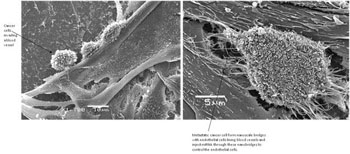Nanobridges Transport Pro-Metastatic MicroRNAs from Cancer Cells to Surrounding Normal Tissues
By LabMedica International staff writers
Posted on 30 Dec 2015
Scanning electron microscope images revealed that spreading breast cancer cells generated "nanobridges" to connect to surrounding endothelial cells in order to transfect them with pro-metastatic microRNA molecules.Posted on 30 Dec 2015
MicroRNAs (miRNAs) are a class of about 20 nucleotides-long RNA fragments that block gene expression by attaching to molecules of messenger RNA (mRNA) in a fashion that prevents them from transmitting the protein synthesizing instructions they had received from the DNA. With their capacity to fine-tune protein expression via sequence-specific interactions, miRNAs help regulate cell maintenance and differentiation.

Image: Metastatic cancer cells form nanoscale bridges with endothelial cells lining blood vessels and inject miRNA through these nanobridges to control endothelial cells (Photo courtesy of Dr. Shiladitya Sengupta, Brigham and Women\'s Hospital).
While metastasis is a major cause of mortality and remains an obstacle in the search for a cure for cancer, little is known about metastatic cancer cells and endothelial cross-talk, which occurs at multiple stages during metastasis.
To better understand this process, investigators at Brigham and Women's Hospital (Boston, MA, USA) used scanning electron microscopy (SEM) techniques to observe the growth of a mixture of endothelial cells and metastatic breast cancer cells on a three-dimensional tumor matrix. They found that instead of adhering to themselves to form a sphere, the metastatic breast cancer cells spread out along the model's blood vessels. SEM revealed long, thin tubes (nanobridges) extending outward from the cancer cells to connect them to surrounding normal tissue.
Additional results published in the December 16, 2015, online edition of the journal Nature Communications revealed that contact with cancer cells caused changes in the molecular profiles of some of the normal endothelial cells. The investigators hypothesized that microRNAs were being transferred over the nanobridges into the endothelial cells, and it was found that the transformed endothelial cells had begun to express two microRNAs that had previously been implicated in metastasis.
Some chemotherapeutic agents, such as docetaxel, were shown to disrupt formation of nanobridges in treated cultures, which prevented direct communication between the tumor cells and endothelium. In mice pretreated with this class of pharmacological agent, there was a significant decrease in metastatic tumor burden.
"Metastasis remains a final frontier in the search for a cure for cancer," said senior author Dr. Shiladitya Sengupta, professor of bioengineering at Brigham and Women's Hospital. "For the past five years we have studied how cancer travels to other parts of the body, and what we find is that communication is key. Our study opens up new avenues for exploration and suggests that these nanoscale membrane bridges may represent new therapeutics in managing metastatic breast cancer. We plan to continue searching for and evaluating treatments that take aim at these conduits."
Related Links:
Brigham and Women's Hospital













